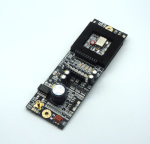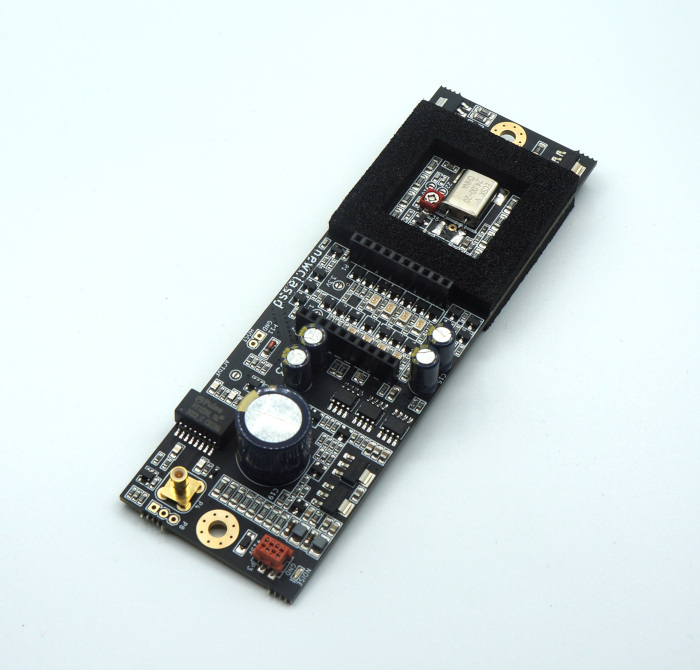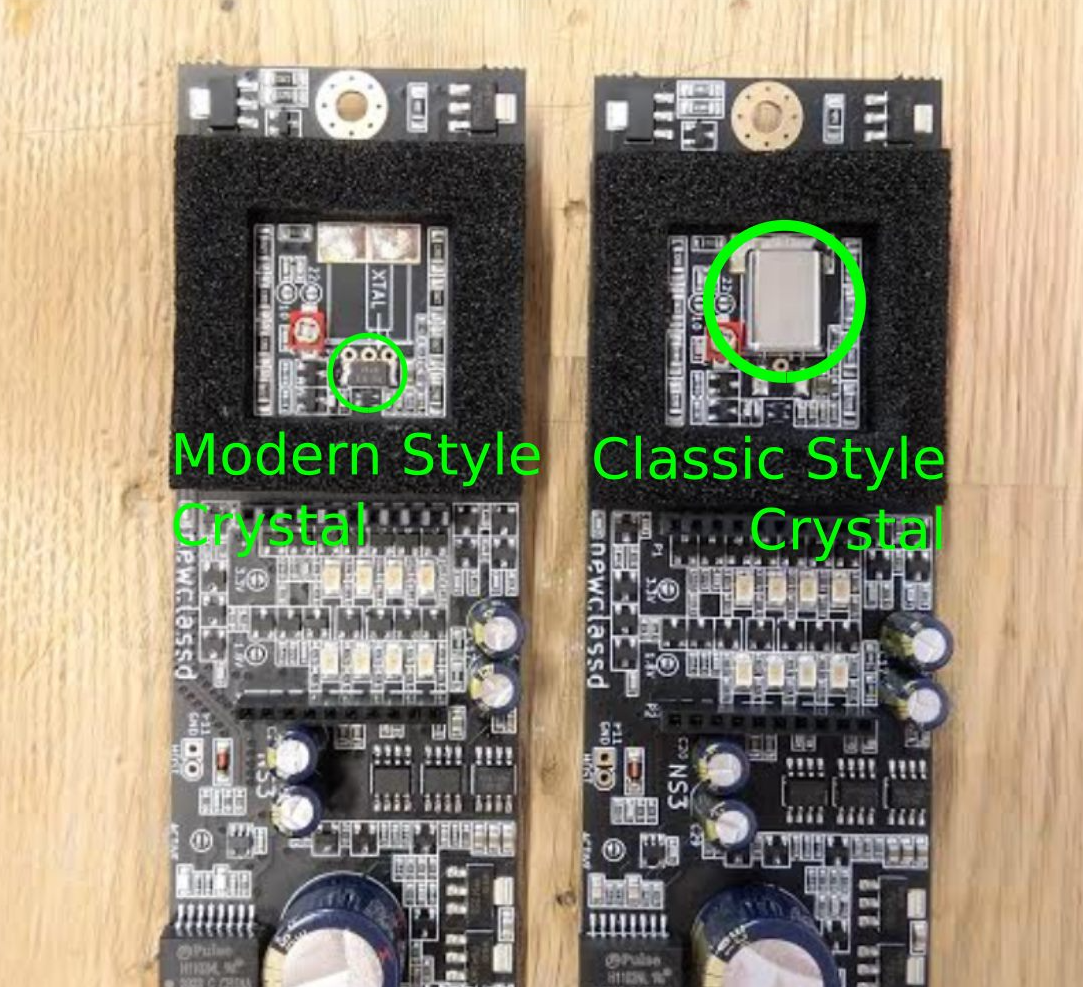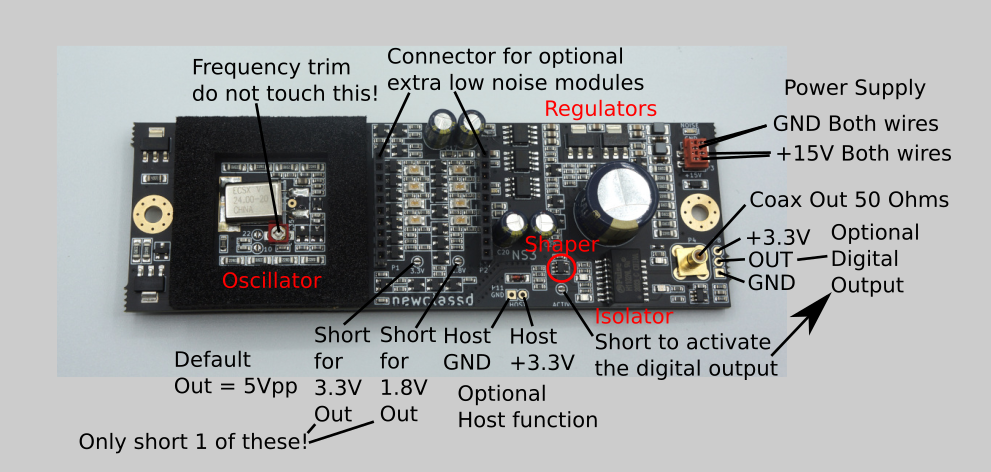Ask technical questions, discuss hifi, show pics of your gear: Join us on


Shopping Cart |

Accepted..
Cookie information:
We only use a session cookie. This cookie stores your shopping basket while your are navigating on our pages. The moment you leave NewClassD.com, the session cookie is destroyed, and erased. | | |
Neutron Star 3 Audio Reference Clock 6.000000 MHz




|

Neutron Star 3 reference clock incl. Cables 6.000000 MHz |
| | Ex VAT is correct if you purchase your goods outside EU. If you are inside EU, please click the Ex VAT text to see the price including VAT. If you are outside EU local VAT may apply when the shipment enters your country. This amount is not included in the above amount. |
|
| | |
Ultimate performance Discrete Audio OP-AMP's for upgrading any existing Audio product. This module is a simple and effective way to upgrade your CD, DVD or Blu-Ray player, or preamplifier, or network stream player by removing the existing OPAMP IC's and dropping these into the motherboard. This way any Audio equipment can upgrade to a true Discrete High End Analog stage with outstanding performance. It will drop directly into DIP8 single footprints in a CD, DVD, Preamp or soundcard.
This Discrete OPAMP based on brand new technology, with a folded cascode which eliminates semiconductor capacitances, and provides world class sound performance in your existing product. Compared to other similar products this module is made with high end thin film resistors, and a special high-speed circuit with extremely low THD (0.0003%). Current mirrors are made with lowest noise LED references. Resulting in a clean and coherent sound experience, with complete 'black background'.
Discrete High End Sound Quality
By start of 2010 we introduced these new discrete OPAMP's. Most signal sources, and many power amplifiers use operational amplifiers, as main active component, for amplifying, filtering and impedance conditioning of the audio signal. This means the audio properties of these OPAMPs have a big impact on the sound of your audio equipment. Even OPAMP's with good data, like very low THD specification still have very different sonic properties. This tells us that technical spec is not the whole story and defining factor for sound quality.
Classically there has been a few IC OPAMP's considered good for Audio, and with golden sound performance. But today it is in debate if even these sometimes very expensive chips are really capable of getting the best sound out of your CD player, DVD player, preamplifier or power amplifier. And when you add the fact that most
| |
commercial audio players use cheap OPAMP's and not the classical 'golden' OPAMP's that would cost hundreds of times more, there is place for improvement.
This discrete OPAMP is based on a novel 12 transistor circuit with very high linearity. Therefore low open loop amplification is possible, leading to natural, relaxed sound with a very high detail and perfect tonal balance.
The circuit implies current mirrors, which are here implemented with ulra low noise green LED's. This gives the amplifier very good low noise performance.
The input stage is bipolar unlike some other discrete OPAMP's available on the market. This gives our module the best possible stability under all real-life uses, and also protects it better against static electricity. Bipolar transistors also tend to sound cleaner and more dynamic than FET's in the input stage.
|
By start of 2015 we also introduced the Special Edition, with higher Class A point, See HERE...
With a reference Clock and a couple of voltage regulators this is the cheapest way to achieve true high-end sound performance, even from mid range audio equipment.
| |
| | |
Ultimate performance Discrete Audio OP-AMP's for upgrading any existing Audio product. This module is a simple and effective way to upgrade your CD, DVD or Blu-Ray player, or preamplifier, or network stream player by removing the existing OPAMP IC's and dropping these into the motherboard. This way any Audio equipment can upgrade to a true Discrete High End Analog stage with outstanding performance. It will drop directly into DIP8 single footprints in a CD, DVD, Preamp or soundcard.
This Discrete OPAMP based on brand new technology, with a folded cascode which eliminates semiconductor capacitances, and provides world class sound performance in your existing product. Compared to other similar products this module is made with high end thin film resistors, and a special high-speed circuit with extremely low THD (0.0003%). Current mirrors are made with lowest noise LED references. Resulting in a clean and coherent sound experience, with complete 'black background'.
Discrete High End Sound Quality
By start of 2010 we introduced these new discrete OPAMP's. Most signal sources, and many power amplifiers use operational amplifiers, as main active component, for amplifying, filtering and impedance conditioning of the audio signal. This means the audio properties of these OPAMPs have a big impact on the sound of your audio equipment. Even OPAMP's with good data, like very low THD specification still have very different sonic properties. This tells us that technical spec is not the whole story and defining factor for sound quality.
Classically there has been a few IC OPAMP's considered good for Audio, and with golden sound performance. But today it is in debate if even these sometimes very expensive chips are really capable of getting the best sound out of your CD player, DVD player, preamplifier or power amplifier. And when you add the fact that most
| |
commercial audio players use cheap OPAMP's and not the classical 'golden' OPAMP's that would cost hundreds of times more, there is place for improvement.
This discrete OPAMP is based on a novel 12 transistor circuit with very high linearity. Therefore low open loop amplification is possible, leading to natural, relaxed sound with a very high detail and perfect tonal balance.
The circuit implies current mirrors, which are here implemented with ulra low noise green LED's. This gives the amplifier very good low noise performance.
The input stage is bipolar unlike some other discrete OPAMP's available on the market. This gives our module the best possible stability under all real-life uses, and also protects it better against static electricity. Bipolar transistors also tend to sound cleaner and more dynamic than FET's in the input stage.
|
By start of 2015 we also introduced the Special Edition, with higher Class A point, See HERE...
With a reference Clock and a couple of voltage regulators this is the cheapest way to achieve true high-end sound performance, even from mid range audio equipment.
| |
| | |
Voltage Range: +/- 5V to +/- 25V.
Supply current: typ. 7 mA.
Power Consumption typ. 0.2 Watts.
Slew Rate: 20 V/uS.
Dimensions: (Footprint on PCB) L:24mm W:13mm H: 31mm.
| |
| | |
Style of crystal
The Neutron Star can be equiped with either the calssic style of crystal case, or the
modern style SMD mounted case. The difference is in the case onle, and the performance of these two types
of crystals are identical. We have used the classic style in the last 25 years, but the market
is moving towards the modern style, so i many cases we can only get the right frequencies in the modern style.


This cheat sheet shows all you need to know to correctly connect the Neutron Star 3.
1..First connect the clock signal from the gold plated connector with the supplied cable to your player or device.
2..Determine if you want output signal level at 1.8, 3.3 or 5 Vpp. The value should correspond to the supply voltage of the chip you are connecting the clock signal to.
You can set the voltage by shorting one or none of the solder bubbles shown at the bottom of this image.
3..Connect +15V power to BOTH pins 3 and 4 of the orange power connector, and Power GND to BOTH pins 1 and 2 of the power connector.
If you only coonect pins 1 and 4, the Neutron Star 3 will NOT work. If you got the bundle power supply,
you can simply use the end to end connector cable supplied with the set.
4..HOST function. When the host pin is unconnected, the clock signal is always ON. If the HOST pin is pulled low
the clock signal will go off. You use this function in case you need to have the clock powered up all the time, but the device can turn
it's supply voltage on and off like standby. Simply connect the HOST pin to +3.3V of your device, and remember also the
GND pin of that same connector to GND of your device. The the clock will turn ON when ever the device is ON.
This function is optional.
5..ACTIVE output (optional). If your device uses a cmos oscillator rather than a crystal, it might be easier to use the ACTIVE output.
Simply connect GND (pin 4) and 3.3V or 5V (pin 8) and lastly OUT (pin 5) to the oscillator footprint of your device.
No need to set the output voltage in this case as this is only working for the analog output.
Short the ACTIVE bubble with some solder, and you are all set. As the ACTIVE output does not use
COAX cable, you must keep the OUT wire very short, and never longer than 5 - 10 cm.
This function is optional.
| |
|
|
|